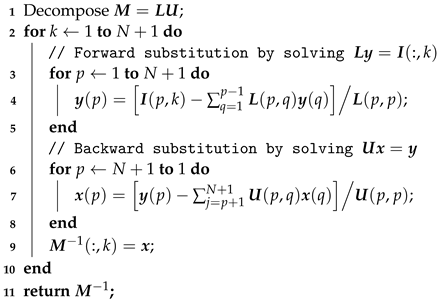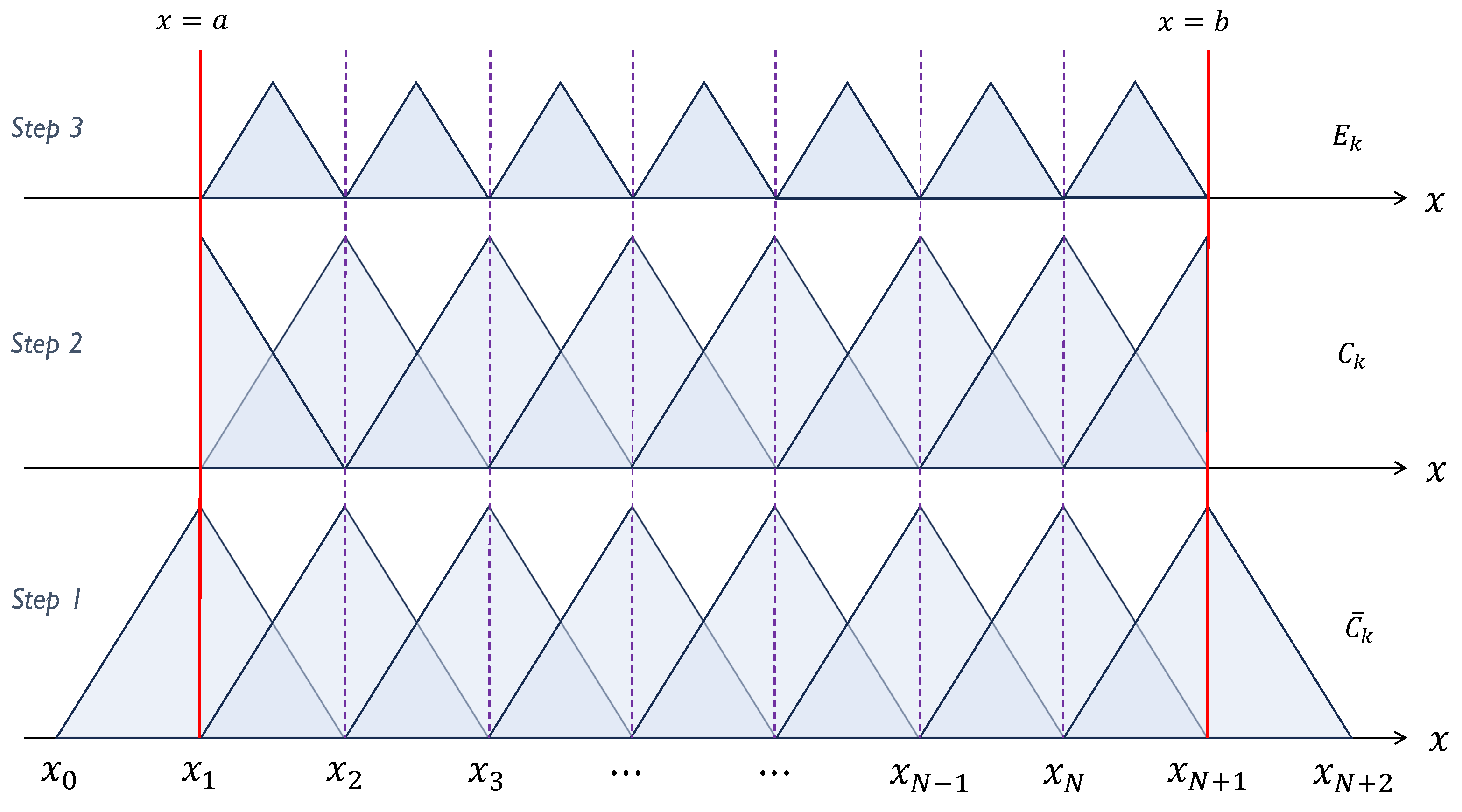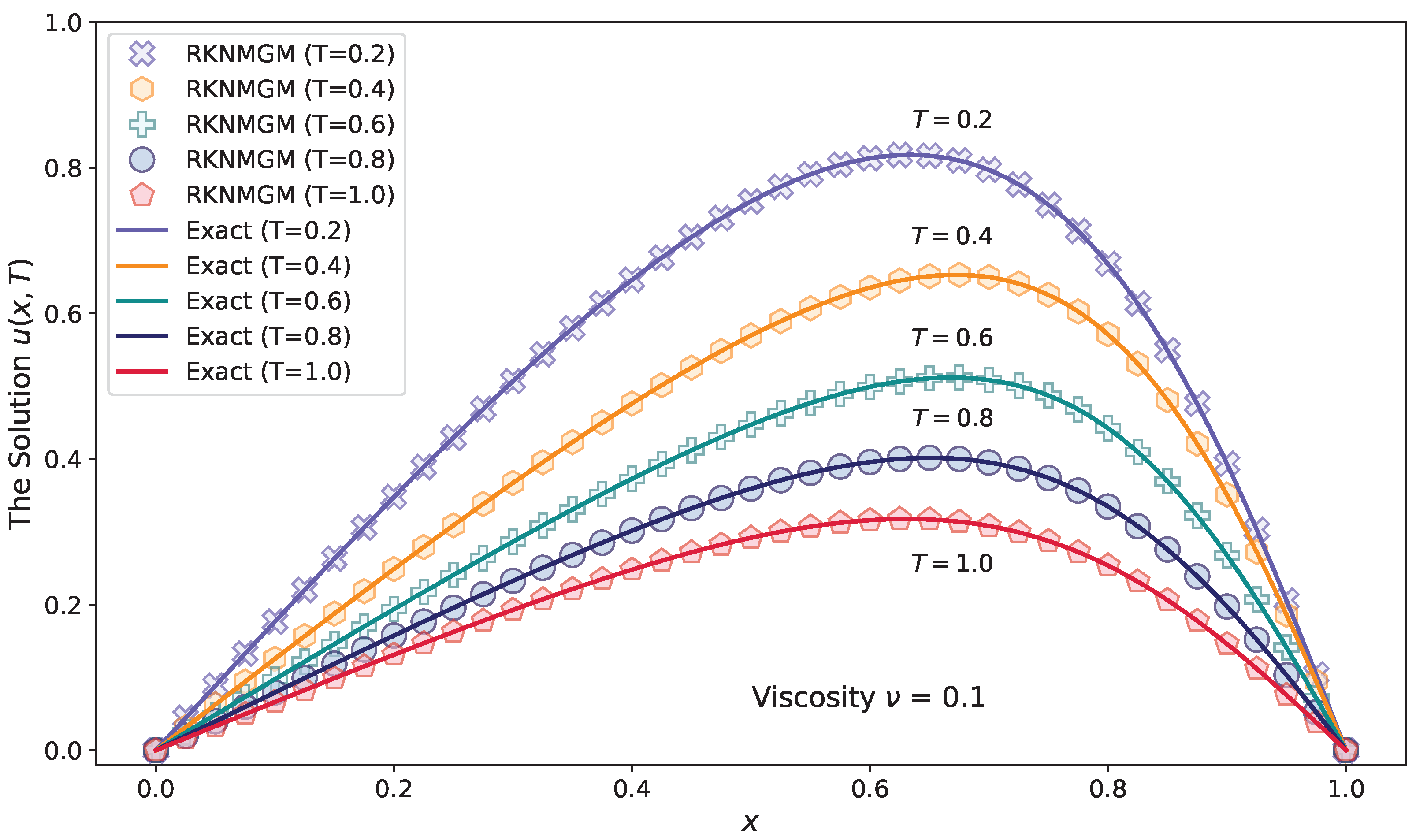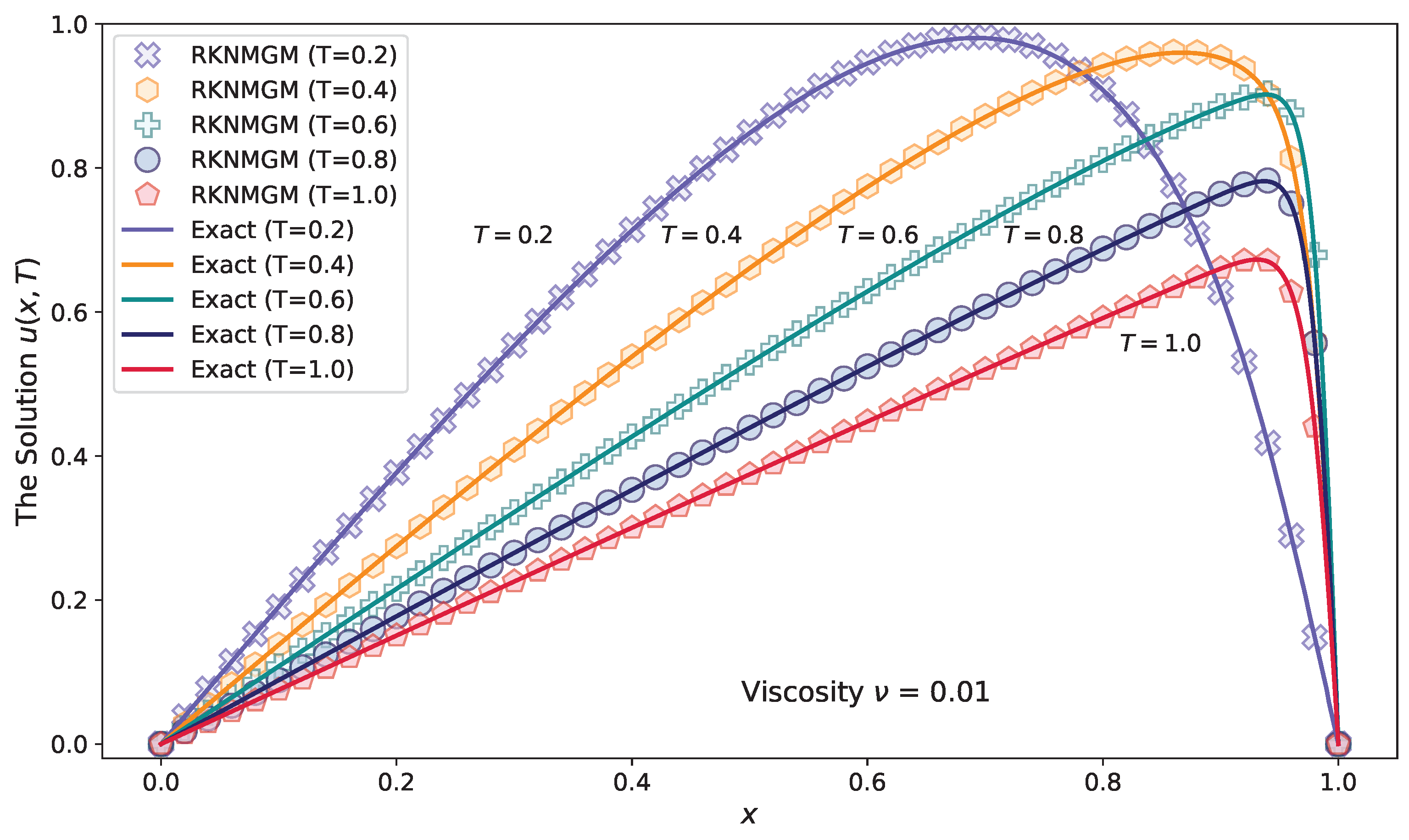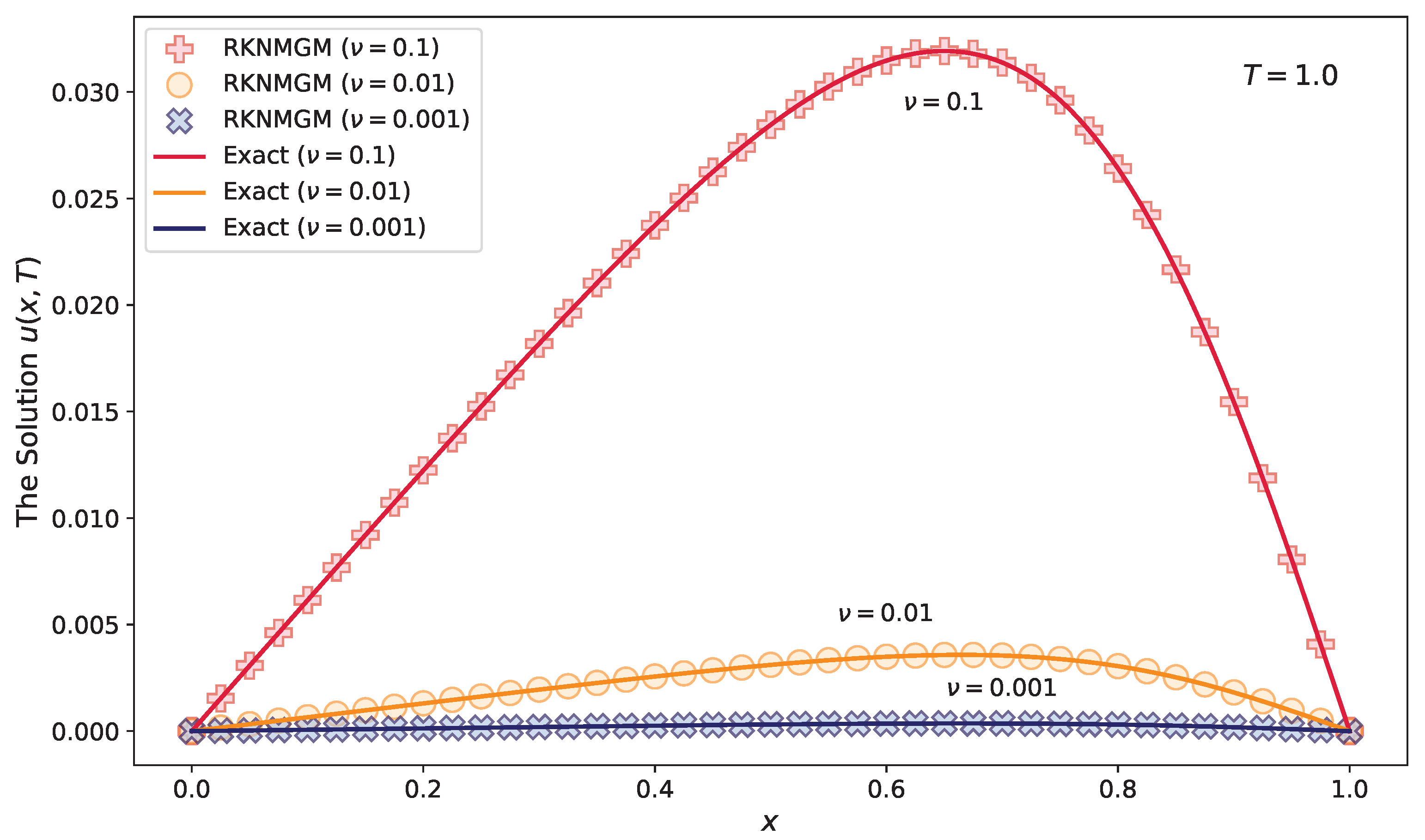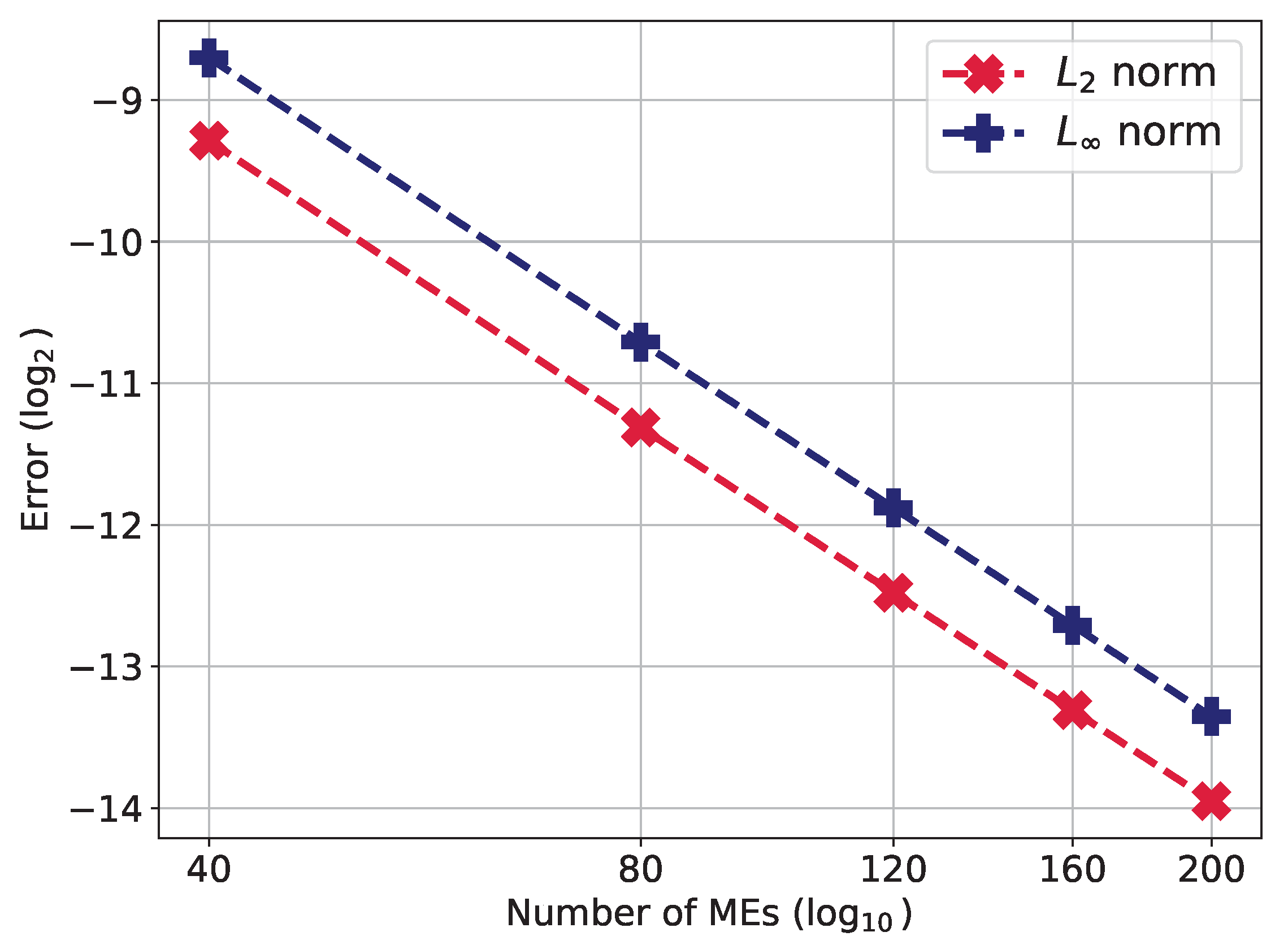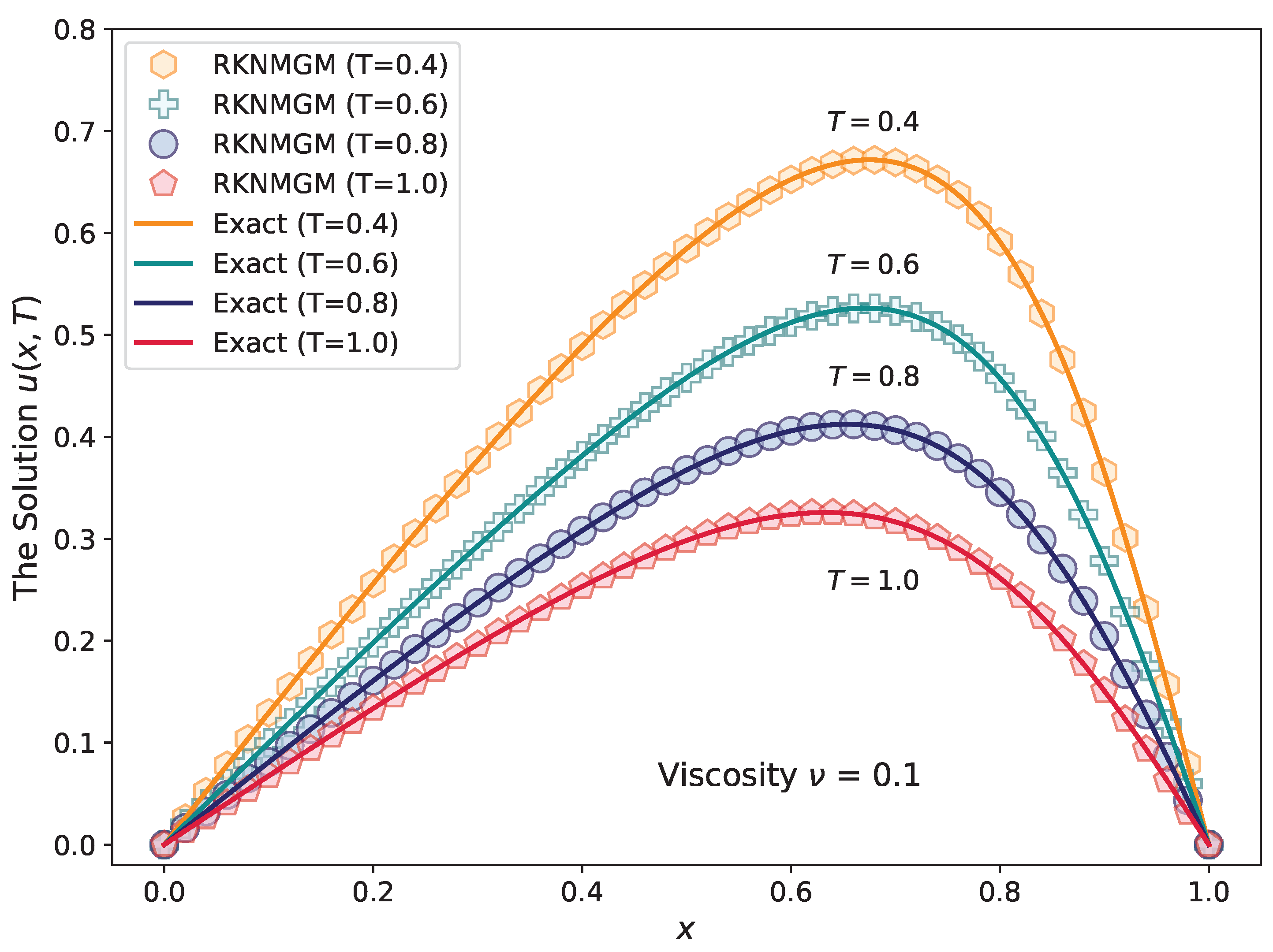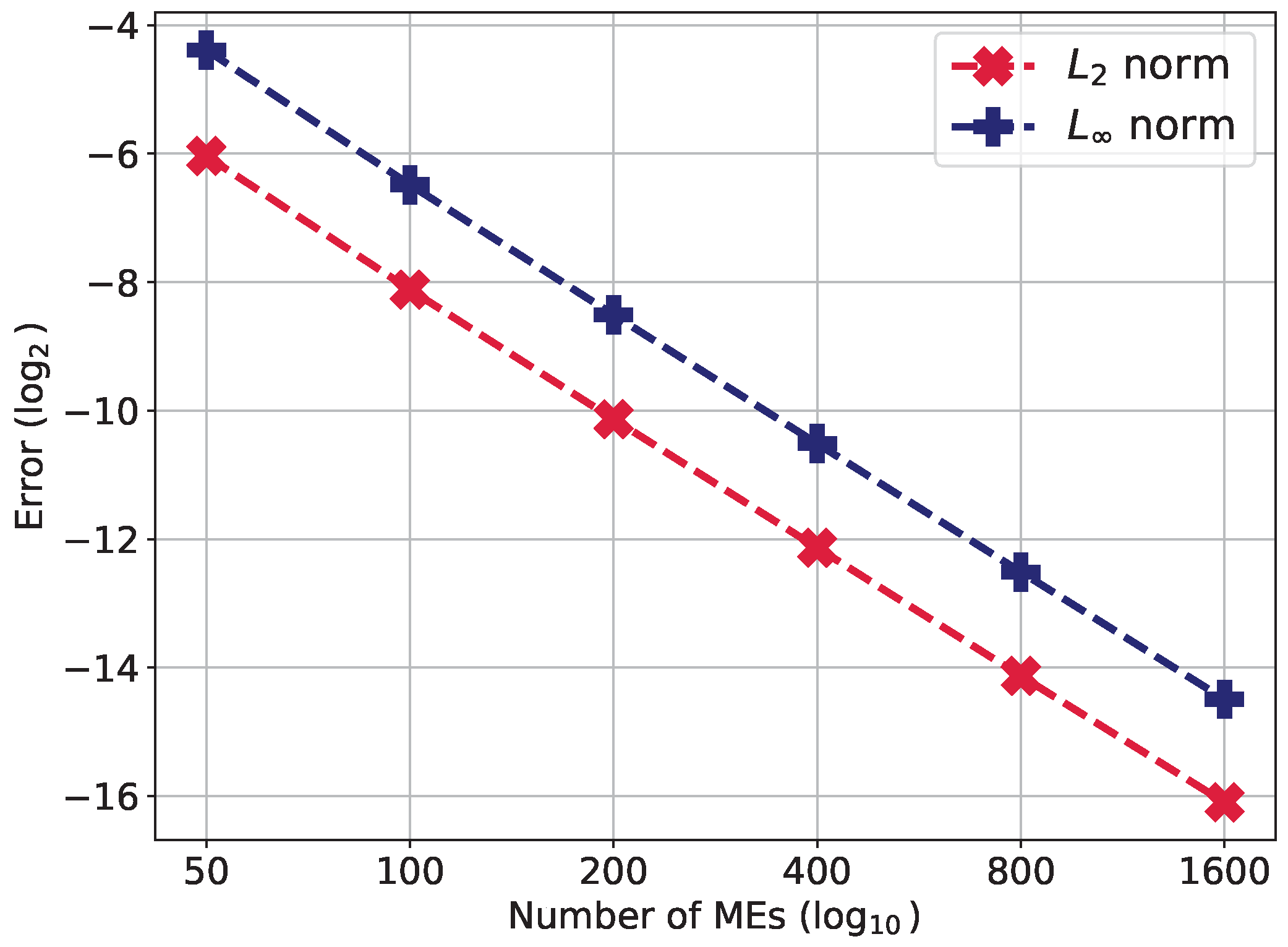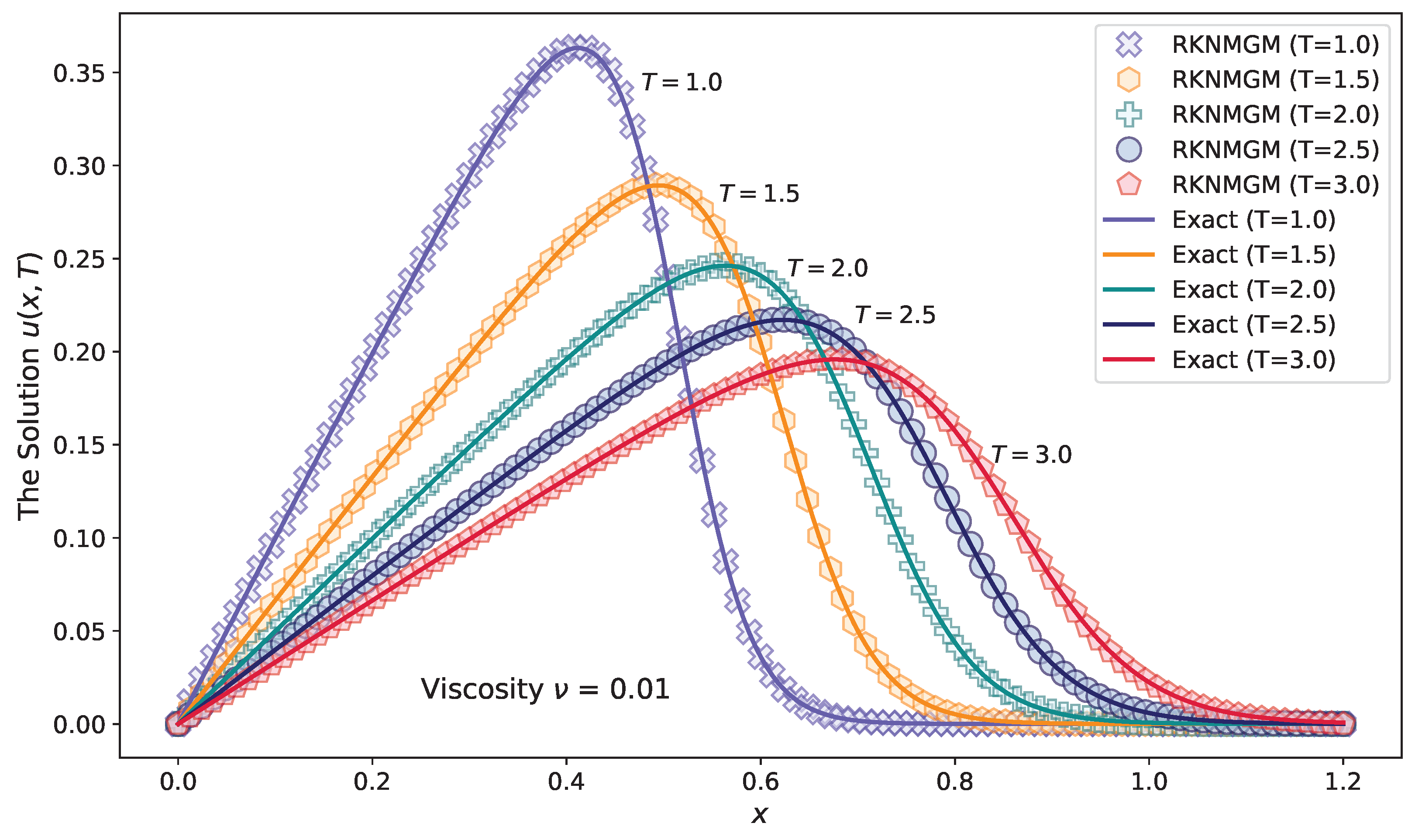1. Introduction
Burgers’ equation [
1] is a fundamental quasi-linear partial differential equation (PDE) that appears in various fields, including gas dynamics, acoustic wave, biological process, and traffic flow modeling. It provides a simpler version of the Navier–Stokes equations, capturing the interplay between nonlinear convection and diffusion. The focus of this study is on the following problem:
in which
represents the fluid velocity,
is the initial time, and
denotes the kinematics viscosity coefficient.
indicates the Reynolds number.
Despite its simple form, the Burgers’ equation presents significant analytical challenges due to its nonlinearity, with exact solutions only available for specific cases [
2,
3]. Computationally solving Burgers’ equation is also hindered by the complex interaction between the nonlinear convection term and linear dissipation. In convection-dominated scenarios, where the viscosity
is small, resolving sharp gradients and shock waves becomes particularly difficult. These difficulties necessitate the development of stable and accurate numerical techniques.
Throughout the past several decades, different computational techniques have been introduced to solve this challenge, including the finite difference method (FDM) [
4,
5,
6,
7], finite element method (FEM) [
8,
9,
10], spectral methods [
11,
12,
13,
14], and finite volume method (FVM) [
15,
16]. However, the performance of these approaches depends heavily on the quality of the spatial discretization. Accurately resolving steep gradients often requires fine meshes, which increase computational cost and can lead to numerical instabilities. Although the local discontinuous Galerkin method (LDG) [
17,
18,
19] helps mitigate mesh dependency, it introduces additional degrees of freedom within each element, further escalating computational costs.
Alternatively, meshless methods avoid the reliance on structured grids and can achieve better flexibility in capturing complex nonlinear behavior, such as the characteristic-based element-free Galerkin method (EFCGM) [
20,
21], semi-Lagrangian EFG method [
22], reproducing kernel particle method [
23], radial basis function method [
24], and finite point method [
25]. The numerical manifold method (NMM) [
26], a partition-of-unity mesh-free approach [
27], utilizes a dual cover mesh for spatial discretization, offering greater flexibility in representing complex geometries and material domains. Compared to conventional mesh-based approaches, this method does not require the mesh to strictly conform to problem geometry shape and achieves higher accuracy with fewer degrees of freedom. Due to these advantages, the NMM has shown significant potential in solving nonlinear PDEs, particularly in solid mechanics [
28,
29,
30,
31,
32,
33,
34,
35,
36] and fluid flow problems [
37,
38,
39].
In our previous work [
40], we enhanced the NMM by integrating the characteristic method to solve the Burgers’ equation. The results showcased the high accuracy and stability of this approach across a wide range of benchmark examples, demonstrating its capability to yield reliable solutions. However, a notable challenge arises as the viscosity coefficient
decreases. In this case, the method necessitates smaller time steps and finer cover sizes to accurately capture sharp gradients. This issue has a significant impact on computational efficiency.
The Hopf–Cole (H-C) transformation was independently proposed by Hopf [
41] and Cole [
2] in 1950s. This transformation can convert the Burgers’ equation into a linear diffusion equation by removing the nonlinear convective term. In this way, the solution process of the original problem can be greatly simplified [
42,
43]. Since then, several studies [
44,
45,
46,
47,
48,
49,
50] have applied this function transformation technique to numerically solve the Burgers’ equation, and diversified numerical methods were adopted to discretize the transformed linear diffusion equation. Öziş et al. [
51] employed the FEM with linear elements to solve the resulting linear diffusion equation, while Zhao et al. [
52] applied an LDG method. Mukundan and Awasthi [
53] also tackled the transformed equation using the method of lines combined with a backward difference scheme.
The present study develops a Runge–Kutta numerical manifold Galerkin method (RKNMGM) to tackle the Burgers’ equation using the H-C transform. The problem domain is spatially discretized with a dual cover mesh. The unknowns of the transformed equation are approximated using piecewise constant cover functions combined with first-order polynomial weighting functions over manifold elements. Temporally, the time derivative term is integrated using the total variation diminishing Runge–Kutta scheme with second-order accuracy (TVD-RK2) [
54]. Due to the TVD property for limiting numerical oscillations, this scheme offers enhanced efficiency and stability compared to the explicit Crank–Nicolson method adopted in our previous study [
40]. The full discretization formulation the RKNMGM is derived from is based on the Galerkin weak form, resulting in a symmetric system of equations. The Crout algorithm is utilized to efficiently compute the inverse of the symmetric positive definite mass matrix. Finally, the solution to the original Burgers’ equation is recovered from the results of the transformed problem by applying the H-C transformation once more.
Several benchmark numerical examples on the Burgers’ equation are conducted to assess the performance of the RKNMGM. Diversified parameter settings are considered to ensure a comprehensive evaluation of the method’s robustness. Our results are rigorously compared against exact solutions and alternative numerical approaches, highlighting the accuracy and efficiency of the current method. Additionally, we investigate the convergence behavior of the RKNMGM across various mesh configurations, which provides insights into its stability and reliability under different discretization strategies. Through extensive analysis and discussion, the effectiveness of this method for steep gradient problems is demonstrated.
5. Validation Problems
Problem 1. Given the problem presented in Equations (1)–(3) on withCole [2] gave the exact solutionwhere, using , the coefficients are Below, we employ the RKNMGM scheme to numerically solve this problem. Using Equation (
4), we transform the governing equation from Equation (
1) into Equation (
5), then convert the IC in Equation (
31) into
and the homogeneous BC in Equation (
7) becomes
As shown in
Figure 2, we evaluate the convergence characteristics of the RKNMGM for this problem with
when
. Five different ME sizes, i.e.,
, are adopted. During the computations, we keep
as the time step length. It can be observed from the figure that the global errors of the RKNMGM in the
and
consistently decrease while refining the spatial discretization, showcasing the good stability and convergence characteristic.
Then, we examine the numerical solution of Problem 1 for different
T while using a viscosity coefficient of
. For each case, the parameters of the RKNMGM are set to be
and
. As depicted in
Figure 3, we present the comparison of the solution curves produced by the RKNMGM against the exact solutions. The figure clearly indicates that the results from our method closely match the analytical formulations.
Table 1 presents the comparison of our results with exact solutions and those provided by the EFCGM [
20] and the ENMCGM [
40] at specific points and different times. Here, the EFCGM adopts 20 nodes with
, the ENMCGM uses
with
, while the RKNMGM employs
with
. Compared with the EFCGM, our method needs finer discretization to achieve similar accuracy. However, the RKNMGM can strictly satisfy the homogeneous BC, which is challenging for the EFCGM due to using the MLS approximation. Besides, the EFCGM adopts the cubic spline weight function and utilizes Gaussian quadrature to calculate integrals, while our method employ a linear weight function and directly uses exact integration formulations. Compared with the ENMCGM, the present method requires much less MEs and smaller time step size, and the accuracy is better. These comparisons demonstrate that the efficiency and effectiveness of our method is on par with the EFCGM as well as the ENMCGM.
We then address this problem with a viscosity coefficient of
using the RKNMGM, employing
and
.
Figure 4 illustrates the comparison between our results and the exact solutions, indicating that the RKNMGM yields an outstanding agreement.
Table 2 provides a comparison of our results and those obtained from various numerical methods with the exact solution across different final times. In this test, the EFCGM adopts 50 nodes with
, the ENMCGM uses
with
, while the RKNMGM employs
with
. The RKNMGM achieves similar accuracy to the EFCGM [
20] while strictly enforcing the homogeneous BC, a challenge for the latter. Additionally, our method proves more accurate than the ENMCGM [
40], even though the ENMCGM uses a finer spatial discretization and smaller time steps.
Problem 2. For Equations (1)–(3) on withWood [3] has provided the exact solution Before performing Algorithm 1 of the RKNMGM for the numerical analysis on this problem, we use Equation (
4) to transform Equation (
1) into Equation (
5). Taking the parameter
, we use the H-C transform to turn the IC in Equation (
36) into
and adapt the homogeneous BC in Equation (
7) into the Neumann BC in Equation (
35).
As shown in
Figure 5, the numerical results of the RKNMGM for Problem 2 are compared against the analytical solutions when
. Diversified viscosity coefficients are considered, i.e.,
, and smaller
leads to a more smoothly changing curve. During the computation, the time step size and ME size are set as
and
, respectively. A close agreement with the exact solutions can be found from
Figure 5. It is indicated that our method is effective and stable.
Then, we evaluate the convergence performance of the RKNMGM for Problem 2 in the case of
. In
Table 3, the global errors of the RKNMGM are demonstrated for different ME numbers and viscosity coefficients. During the computations, set
, and diversified viscosity coefficients are adopted. It can be observed from the table that refining the dual cover mesh can give more accurate results for all of the cases. Besides, we can also find the phenomena that when the viscosity coefficient
is reduced, the errors in both the
and
norm decrease.
Next, we evaluate the results from the current method against those obtained from the ENMCGM [
40] for Problem 2, focusing on two cases:
and
. During the test, both methods utilize 2000 MEs. The RKNMGM employs a time step of
, while the ENMCGM uses
.
Table 4 presents the numerical results and the relative errors with respect to the analytical solution in Equation (
37). The comparison reveals that the present method demonstrates greater accuracy and stability for both
and
. Further, the RKNMGM can use a larger time step size while achieving better computational performance.
Furthermore, the accuracy of the RKNMGM is compared with higher-order methods, such as the fifth-order FVM (FVCW) [
15] and the collocation methods proposed by Ganaie [
13] and Mittal [
12]. In this test, these three references adopt the parameters
and
, while we choose
and
.
Table 5 provides the exact solutions and numerical results on specific points. The data indicate that the RKNMGM demonstrates good accuracy, while it is slightly lower than that of the FVCW scheme. The latter benefits from the six-order Padé-based approximation. Our method outperforms the other two higher-order collocation methods in terms of accuracy. When using the same computing parameters as adopted in the other three methods, i.e.,
and
, the relative error of our method is
at all of the measured points. Although higher-order approaches exhibit impressive results, they may also demonstrate increased computational complexity. In contrast, the RKNMGM is more simple and easy to implement owing to using constant cover functions and linear weight functions. These comparisons highlight the effectiveness and efficiency of the RKNMGM, showcasing its competitive performance among various methods using higher-order approximation.
From
Table 4 and
Table 5, it is noteworthy that the present method exhibits almost uniform relative errors across different points, whereas the the other four methods do not possess this characteristic. This can be attributed to the time integration scheme adopted in this work, which maintains the TVD property, effectively suppressing numerical oscillations near sharp gradients.
Problem 3. Next, consider Equations (1)–(3) on withThe exact solution of this problem is the same as Equation (32), but the coefficients and take the following formulation [4]:where . Using Equation (4), Equation (1) is transformed into Equation (5), the IC in Equation (36) becomes , , and the BC in Equation (7) turns to be Equation (35). For this example, we first assess the convergence performance of the RKNMGM using the time step size
and various ME sizes—specifically,
,
,
,
, and
. Here, we use a viscosity coefficient of
and set the final time as
. As illustrated in
Figure 6, the global errors are presented in both
and
norms. The figure clearly demonstrates that our method converges as the discretization is refined.
As shown in
Figure 7 and
Figure 8, the results of the RKNMGM align well with the exact solutions, corresponding to the diffusive coefficients
and
. In these computations, we adopt
and
. Notably, these curves exhibit similarities to those observed in Problem 1 owing to their similar exact solution formulations.
We further assess the accuracy of the RKNMGM at specific points for this example. For this test, the profile of the problem includes
and
.
Table 6 presents a comparison of the numerical results obtained from our method with those solved by the fourth-order FDM [
4] and the ENMCGM [
40]. In the tests, the FDM uses
with
, the ENMCGM employs
with
, and we adopt
with
. It is evident that the RKNMGM can provide higher accuracy than the other two methods. Although our approach requires a finer mesh than the fourth-order FDM, it utilizes only constant cover functions and linear approximations, significantly reducing computational cost. Moreover, compared to the ENMCGM, which uses 2000 MEs, our method achieves greater accuracy with just 500 MEs, demonstrating the remarkable efficiency of the current approach.
Problem 4. There exist the following specific solutions [8] for the problem presented in Equations (1)–(3)where , . Consider the Burgers’ equation on
, with Equation (
42) at
as the IC, i.e.,
In this case, the BC in Equation (
3) becomes
Equation (
41) provides the exact solution for this problem.
To numerically solve this problem with the RKNMGM, we use Equation (
4) to convert Equation (
1) into Equation (
5) and transform the IC and BC into the following forms:
Figure 9 shows the convergence performance of the RKNMGM for Problem 4 with
. Various spatial discretizations are considered, including cases with 50, 100, 200, 400, 800, and 1600 MEs. A consistent time step of
was used throughout the computations. As depicted in the figure, the global errors of the RKNMGM decrease with increasing ME numbers, demonstrating clear convergence.
Table 7 compares the accuracy of the RKNMGM with other numerical methods, including the FEM [
8] and our previously proposed ENMCGM scheme [
40]. The ENMCGM utilizes 2000 MEs and employs
for both of the cases
and
, while the present method utilizes
and uses 400 MEs and 2000 MEs for
and
, respectively. Here, the computing settings used in the FEM have not been given by the author. The accuracy is evaluated in terms of global errors in both
and
norms for two cases of viscosity,
and
, with results presented for three different final times
T. The RKNMGM demonstrates superior accuracy compared to the other two methods. This comparison shows the significant advantage of the RKNMGM in computational efficiency.
Figure 10 displays our results for Problem 4 with a viscosity coefficient of
, compared to the exact solution. We use a time step size of
and 200 MEs. As the final time
T varies from 1.0 to 3.0, the curve becomes progressively smoother. The figure clearly demonstrates a close correspondence between our results and the exact solutions.
Additionally,
Figure 11 presents our findings alongside the exact solution for this example with
. In this case, we maintain a time step of
while refining the spatial discretization to 2000 MEs. Noticeable steep gradients are evident in the curves for
, and
. Overall, it is evident that the results from the RKNMGM closely match the exact solutions.

